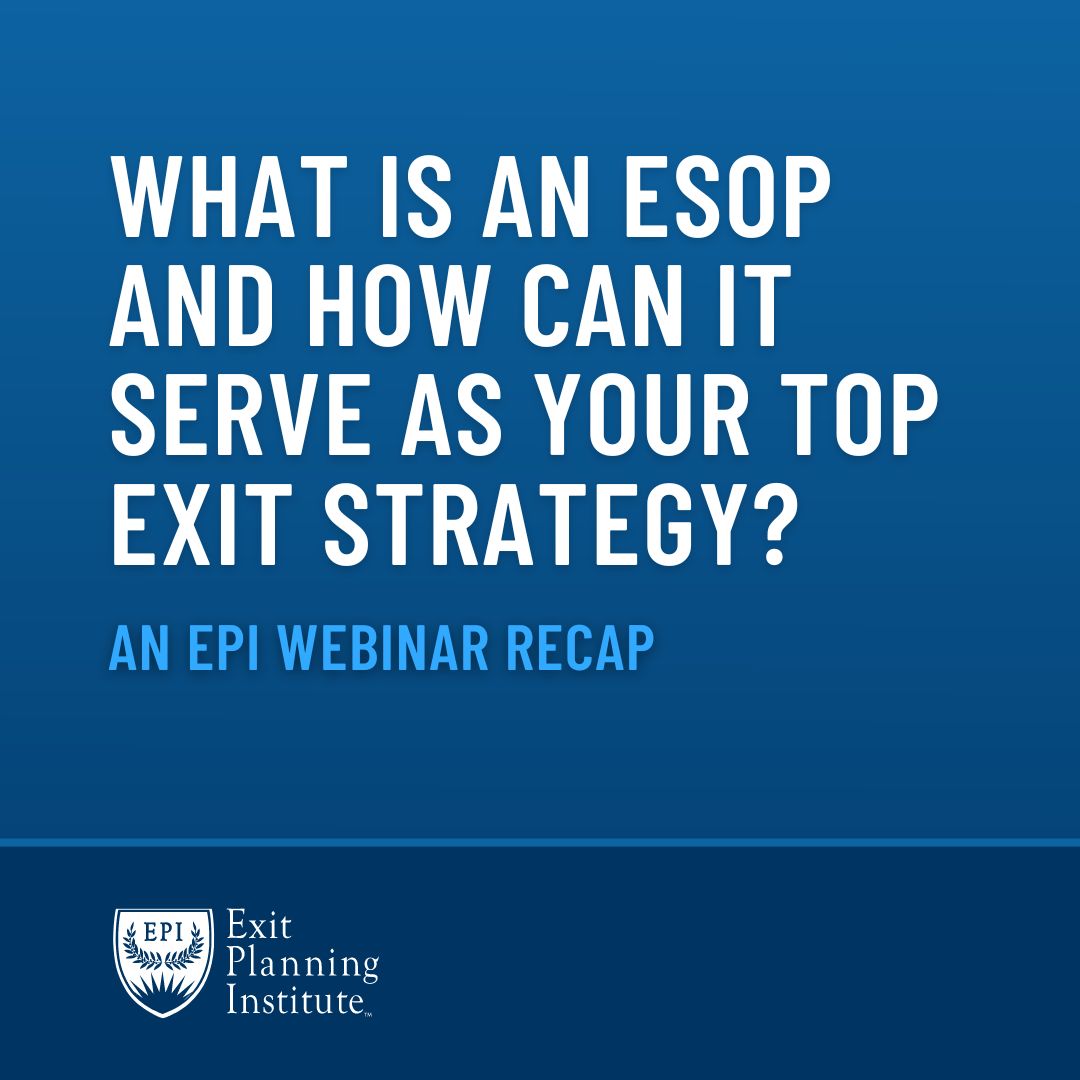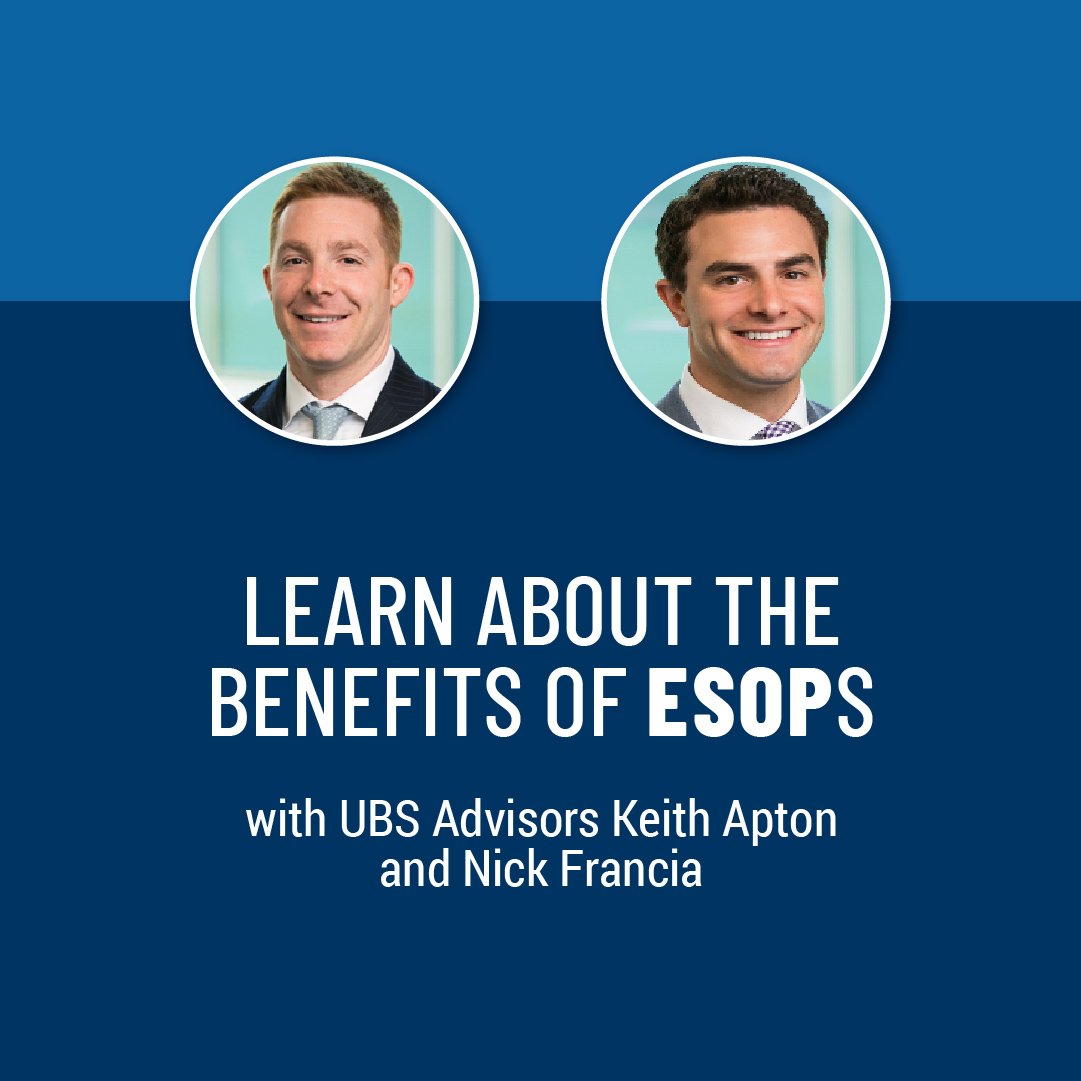
THE EXIT PLANNING BLOG
Keep up-to-date with exit planning, succession planning, industry trends, unique specialty insights, and useful content for professional advisors and business owners.
Share this
What is an ESOP and How Can It Serve as Your Top Exit Strategy?
by Colleen Kowalski on July 27, 2023

An ESOP, or employee stock ownership plan, provides a tax-advantaged solution that can meet a company’s needs in a variety of situations. ESOPs can be used to generate shareholder liquidity, create a market for the shares of a closely held company, increase employees’ productivity by making them beneficial owners, and support a tax-advantageous exit strategy for departing shareholders.
In his webinar, “ESOPs as an Exit Planning Strategy,” Mark Russell of SES ESOP Strategies provided a more thorough understanding of ESOPs as a business exit planning strategy, including the options, mechanics, benefits, risks, and ideal candidates.
Meet Mark Russell of SES ESOP Strategies
Mark Russell is the head of the finance group at SES ESOP Strategies. He works extensively with business owners, evaluating their situations, goals and objectives, and assisting them in preparing for the succession of or exit from their businesses. He performs an analysis of alternatives (including management buyouts, ESOPs, recapitalizations, and minority/majority sales of business) to ensure they have all information necessary to decide the best path to achieve their goals. Mark is a lawyer, CPA-Inactive, CEPA®, CFP®, and Licensed Investment Banker.
What is an ESOP?
An ESOP is a tax-qualified retirement plan for employees, by law, primarily in employer securities. ESOPs, or Employee Stock Ownership Plans, are broad-based plans and allow all employees to participate. Lower paid employees are not discriminated against and each participant has an account with their own personal balance, similar to a 401K plan.
On a national basis, ESOPs account for only 0.88% of all companies with 20 or more employees. ESOPs are still becoming more popular than before because of generational motivations. Mark shares, “Retiring boomer business owners will sell or bequeath $10 trillion worth of private business assets over the next 20 years.” Additionally, there are fewer families that are transferring the business to the next generation than compared to 40 and 50 years ago.
The top goal for many business owners is to transition their business to the next generation. Despite being the goal, only 20-30% of family businesses successfully transition to the next generation. And each subsequent transition to the next generation is less and less likely. An ESOP is, according to Mark, an “Instrument of Corporate Finance” that allows for the shares of the business to end up in “friendly hands,” those of the employees themselves.
Three Types of ESOPs
Mark shared the three types of ESOPs that a company could utilize in its transition strategy. These include Non-Leveraged, Leveraged, and Blended ESOPs.
Non-Leveraged ESOP:
Deductible employer retirement plan contributions are made in cash, which is then used to purchase employer stock. The contributions can also be made directly in stock. The ESOP buys stock from the shareholder. This process is very slow and they do not get a lot of tax benefits up front. The plan could also make a contribution of newly issued stock directly to the ESOP and take a tax deduction for the value of the shares being contributed.
Leveraged ESOP:
Deductible employer contributions are made in cash, then used by the ESOP to repay a loan used to purchase employer stock. The ESOP effectively borrows the money from the company, shareholders, or bank, and buys a large portion of stock up front, and over time the company makes deductible cash contributions to the ESOP and uses that to repay the loan. There is a larger transaction up front, but the ESOP ends up with a lot of stock up front to pay down over time.
Blended ESOP:
Deductible contributions are made in cash, which is held for a future purchase transaction; ESOP purchases employer stock using the accumulated cash for a portion of the purchase price and the proceeds of leveraged financing loan for the balance of the purchase price. Some contributions are made in cash and eventually, the ESOP leverages the remaining balance.
Ideal ESOP Candidates
Mark identifies four key considerations for ideal ESOP candidates. He shares that profitable businesses with a minimum of 20-25 employees, a trusting environment, and a transaction of $2 million or more are the most ideal businesses for ESOPs. Since multiples generally trend higher as EBITDA increases, the more cash flow a company produces the larger the transaction value, resulting in even more tax savings.
In addition to the financial and cultural indicators in businesses that Mark highlights as being well suited for ESOPs, he lists four types of businesses as well. He shares that closely held businesses with no formal exit or transition strategy, middle market companies, and those with non-sale or partial sale situations as well positioned for an ESOP. A non-sale situation is a company looking to raise capital for expansion or acquisition. A partial sale situation is when shareholders want to sell a minority interest into friendly hands.
ESOP Myths
During Mark’s webinar, he discussed four myths that business owners have about ESOPs. These myths have discouraged some from utilizing an ESOP as their exit option. By educating owners and their employees, and disproving these myths, advisors can prepare more companies for an ESOP.
Myth #1: The owner is “giving” the company to the employees.
During an ESOP, the ESOP trustees cannot pay more than “adequate consideration” or the fair market value of the shares as determined by an independent appraiser. The owner therefore only “gives away” the future appreciation, less the interest, of the shares sold to the ESOP based on today’s valuation.
The legal standard of fair market value is the price at which an asset would change hands between a willing buyer and a willing seller when neither is under a compulsion to buy or sell and both parties are well informed. To the extent that there is a competitive sale process, ESOP will likely not be able to match the price. However, it is often close and may even exceed the after-tax proceeds received from a competitive process.
Myth #2: Employees can examine the company’s books and will know how much money the owner and their family are making.
Participants must receive a statement showing the value of their shares, but detailed financial information is not required to be disclosed. Additionally, there will be a trustee who will serve as a fiduciary to the employees, but they will still not disclose the detailed financials.
Some companies, as a matter of culture, choose to share some level of detailed financial information, but that decision is up to the Board of Directors. Some will share more information to show the employees what they could do that would have a direct impact on their retirement account
Myth #3: The owner will lose control of the company.
If the owner maintains majority ownership, that is simply not true. Even if the ESOP owns a majority, or even 100% of the company, the owner usually still has effective control. In many cases, management remains the same following an ESOP transaction as the first stage is usually a minority transaction. ESOP Trustee’s role is to vote for Board members and Board appoints management.
Myth #4: ESOPs have significant transaction costs.
In an ESOP, the transaction costs are usually lower than selling to an outside party and are more than offset by tax savings. Some use the ESOP as a shield because they do not want to sell to a third party. Additionally, ESOP-owned companies perform better than non-ESOP-owned companies. Banks have seen this and have set up ESOP groups in their bank to set up ESOP lending.
The Benefits and Risks of an ESOP
Benefits and Risks to the Company
ESOPs can create resiliency for their companies. For example, the majority of ESOP-owned companies were three to four times more likely to retain staff during the pandemic than other companies. However, accounting can be complex and counterintuitive resulting in a mismatch between compensation expense and contribution deduction. Therefore, ESOPs must plan for and fund future repurchases of stock from employees, which depending on demographics can be significant.
Benefits and Risks to the Selling Shareholders
ESOPs create a market for shares and a mechanism to create shareholder liquidity. If the selling shareholder is still the majority owner post-transaction, they can still maintain control. This acts as a first step in generating initial liquidity for future possible sales. ESOPs are the potential tax-free sale of shares. This also saves up to 15-20% of capital gains plus 3.8% Medicare Surtax.
Benefits and Risks to the Employees
There are several benefits for employees in an ESOP. ESOP participants have the mindset of an owner and are therefore incentivized to perform. Their retirement benefit is equal to the value of the company stock in their account. This acts as an additional retirement benefit in the face of uncertain Social Security. However, there is less diversification in their retirement investment, especially if the company underperforms in the market.
Learn more about ESOPs and other exit options in our free Exit Planning Content Library.
Our Certified Exit Planning Advisors can watch this webinar in their Member Center. Navigate to our Archived Webinars to view this content and all of our 2023 EPI Webinars.
Share this
- Blog (544)
- CEPA (419)
- exit planning (249)
- CEPA community (187)
- Business Owner (169)
- Exit Planning Summit (95)
- EPI Chapter Network (89)
- Value Acceleration Methodology (79)
- Exit Planning Partner Network (76)
- EPI Announcement (49)
- Content (48)
- Webinars (37)
- Excellence in Exit Planning Awards (33)
- Marketing (30)
- 2024 Exit Planning Summit (28)
- 5 Stages of Value Maturity (26)
- Books (24)
- EPI Academy (24)
- EPI Team (22)
- Exit Planning Teams (22)
- Leadership (21)
- 2023 Exit Planning Summit (20)
- family business (20)
- women in business (19)
- Intangible Capital (18)
- Exit Options (17)
- Black Friday (16)
- CPA (15)
- Walking to Destiny (15)
- State of Owner Readiness (14)
- Chapters (13)
- Chris Snider (12)
- National Accounts (12)
- Small business (12)
- charitable intent (12)
- personal planning (12)
- Financial Advisors (11)
- Season of Deals (9)
- 5 Ds (8)
- About us (8)
- Podcast (8)
- Insiders Bash (7)
- Scott Snider (7)
- Christmas (6)
- Exit Planning Content Library (6)
- Case Studies (5)
- Owner Roundtables (5)
- Value Advisors (5)
- financial planning (5)
- Awards (4)
- Circle of Excellence (4)
- Exit & Succession (4)
- Five Ds (4)
- Three Legs of the Stool (4)
- executive training (4)
- Owners Forum (3)
- author (3)
- forbes (3)
- DriveValue (2)
- EPI Thought Leadership Council (2)
- Exit Is Now Podcast (2)
- Peter Christman (2)
- Veteran (2)
- Whitepapers (2)
- Business Owners Forum (1)
- SOOR (1)
- business consultants (1)






